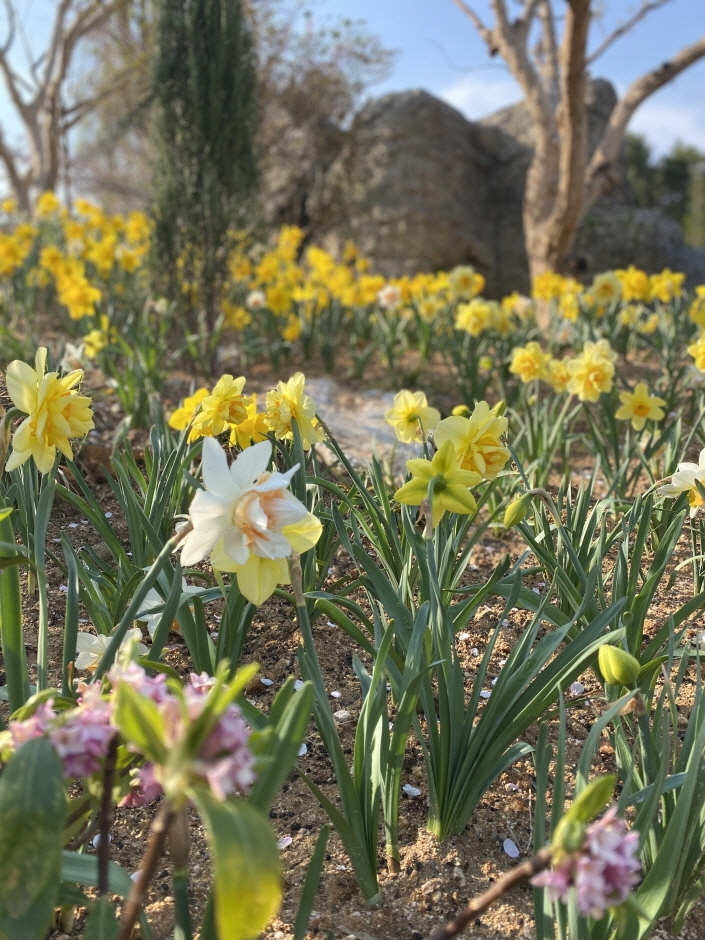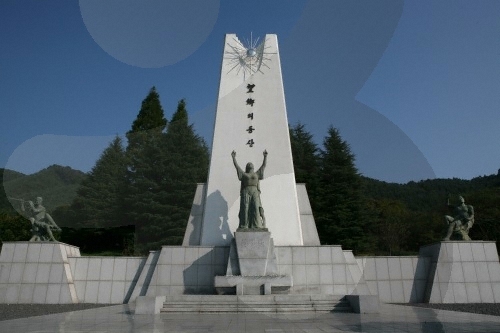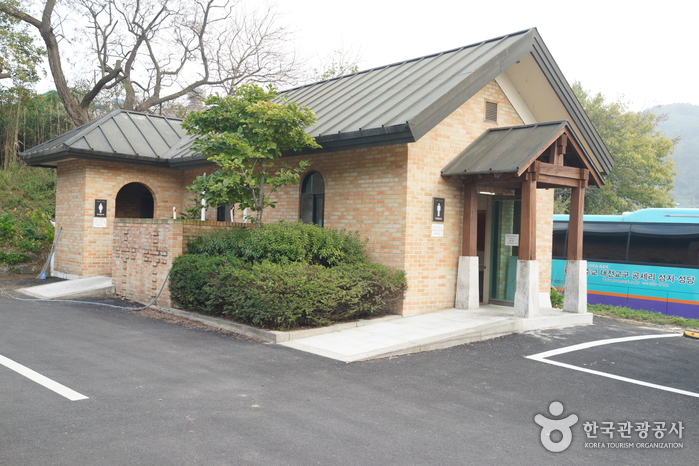Pinnacle Land Spring Flowers Festival (피나클랜드 튤립/수선화 축제)
17.3Km 2023-05-16
20-42 , Wolseon-gil, Asan-si, Chungcheongnam-do
• 1330 Travel Hotline: +82-2-1330 (Korean, English, Japanese, Chinese) • For more info: +82-41-541-2582
Spring has bloomed in Pinnacle Land. Pinnacle Land wakes up from a long winter sleep and spring is in full bloom. A feast of tulips dressed in fancy clothes and daffodils showing off their graceful figure. Visitors can feel the mood under the spring sky of the mountains and 500,000 tulips/daffodils grown by hand with the villagers in Pinnacle Land. Some events may be changed or canceled depending on on-site conditions.
National Mang-Hyang Cemetery (국립 망향의 동산)
17.5Km 2020-03-23
372-8, Manghyang-ro, Seobuk-gu, Cheonan-si, Chungcheongnam-do
+82-41-557-7001
The National Mang-Hyang Cemetery provides a resting place for the souls of Koreans who resided and passed away in foreign lands. The Korean government built the cemetery in 1976 for compatriots who were forced to leave their beloved homeland under the Japanese colonial rule and ultimately passed away in foreign lands. In addition to graveyards, the cemetery also houses the KAL Memorial Tower. Every fall, a large memorial service is held.
Sejong Cheongansa Temple (청안사(세종))
17.8Km 2025-05-20
128-23, Ganeusil-gil, Jeonui-myeon, Sejong-si
+82-44-867-3407
Sitting at the foot of a mountain near Ganeusil Village, Cheongansa Temple belongs to the Jogye Order of Korean Buddhism. It had been believed to have been built in 1900, but the roof tile and white porcelain pieces from the mid-Joseon dynasty period found near the temple suggested that it might have been built even earlier. Cheongsansa had also been thought to be a branch of Biamsa Temple, which is presumably built in the 7th century during the late Baekje kingdom period.
GRAND MOTEL [Korea Quality] / 그랜드모텔 [한국관광 품질인증]
18.6Km 2023-12-04
1344 , Chungseo-ro, Yesan-gun, Chungcheongnam-do
+82-41-334-8934
Grand Motel, in a charming rural village in Yesan-gun, Chungcheongnam-do, is a lodging house run by a rising poet. It offers a choice of rooms: standard rooms, either bedroom-style or Korean ondol-style; or a special room equipped with a desktop PC. Each room has a bathtub to soothe travellers’ fatigue, and there is a lovely ‘healing garden’ with a grass lawn and flowers. Breakfast is not provided, but ramen is always available. Connections are good, with Janghangseong Sinryewon Station and Yesan BusTerminal close by; while local attractions Chusa House and Sudeoksa Temple are 10 - 20 minutes by car.
Sobok Galbi (소복갈비)
18.6Km 2024-02-28
9, Cheonbyeon-ro 195beon-gil, Yesan-eup, Yesan-gun, Chungcheongnam-do
Sobok Galbi is a fourth-generation Korean beef galbi restaurant in Yesan. It has seen many customers over its history, including even the presidents of Korea. Its signature menus are saenggalbi (grilled galbi) and yangnyeom galbi (grilled marinated galbi). Yangnyeom galbi (grilled marinated galbi) takes bone-in galbi, which is marinated in sauce for 3 days and grilled on fine charcoal quickly to seal the juice and enrich the savory flavor. Saenggalbi (grilled galbi) is grilled without any marinade. Other menus include galbitang (galbi soup), seolleongtang (ox bone soup), and naengmyeon (cold buckwheat noodles). Gulhoe (raw oysters) is only offered during winter.
Yesan Beer Festival (예산 맥주페스티벌 )
18.7Km 2023-08-28
967, Hyeongjegogae-ro, Yesan-gun, Chungcheongnam-do
+82-2-549-3864
Yesan Beer Festival in collaboration with The Born Korea offer beers from various regions of Korea as well as BBQs using pork, beef and chicken. The festival will have an atmosphere that can't be matched at city festivals, welcoming visitors to experience the region festival.
Yesan Market & Yesan Fifth-day Market (5th & 10th) (예산시장 / 예산오일장(5, 10일))
18.8Km 2024-06-05
967 Hyeongjegogae-ro, Yesan-eup, Yesan-gun, Chungcheongnam-do
The city of Yesan is home to two notable markets: Yesan Fifth-day Market, which dates back to the 1920s, and Yesan Market, a permanent traditional market. Yesan has historically been a prolific producer of agricultural and livestock products, and the market served as a central point of regional specialties. In fact, Yesan apples are famous across Korea. On days ending with 0 and 5, a fifth-day market is held, which makes the market far larger and livelier. Yesan Rice Soup Street can also be found here.
Gongseri Catholic Church (아산 공세리성당)
19.0Km 2024-10-16
10, Gongseriseongdang-gil, Asan-si, Chungcheongnam-do
+82-41-533-8181
Gongseri Catholic Church was founded in 1894 as the main parish of the Daejeon diocese in Gongse-ri, Inju-myeon that connects Asanman Bay to Sapgyocheon Stream. Early missionaries originally used a common house for church meetings in the early years until in 1897 when a rectory was built, followed by the establishment of the main church in 1922. This was the first Catholic church in Chungcheongnam-do and the religion spread across Anseong, Onyang, and Dunpo to establish regional churches respectively. The grounds have three graves of prosecuted martyrs, a parish and rectory, retreat house, and meeting room. The premises is surrounded by beautiful views of a lush forest.
Unjusanseong Fortress (운주산성)
19.2Km 2021-08-31
Migok-ri, Sejong-si
+82-44-300-3423
Unjusanseong Fortress, also known as Gosansanseong Fortress, is a cultural heritage of the Baekje dynasty. This is a mountain fortress built along the surrounding three mountain peaks in the westernmost and southernmost parts of Unjusan Mountain. The stone fortress wall, which borders three villages in Jeondong-myeon and two villages in Jeonui-myeon, is 3,210 meters long and two meters wide with a x_height that ranges from two to eight meters. The walls follow the natural geographical features of the mountain range, with the southern walls surrounding the mountain's peak.
Remnants of a village can still be observed within the fortress walls, such as the fortress gate and a ritual site. Pieces of earthenware from the Baekje period, porcelain from the Goryeo and Joseon periods, and broken tiles from the Baekje, Goryeo and Joseon periods have been discovered around the site as well.
Geumisanseong Fortress (금이성)
19.2Km 2025-05-20
Songseong-ri, Sejong-si
+82-44-300-3444
Geumiseong is a mountain fortress built on the summit of Geumseongsan Mountain, which rises 430 meters above sea level. It overlooks Jeonui and Cheonan to the north and Geumgang River to the south. The architecture style of Geumiseong Fortress is a combination of the
styles of the Baekje dynasty and the early Unified Silla. Based on the relics found inside the fortress, it is thought to have been built in the Goryeo period. The robustness of the fortress takes advantage of the rugged topography, so much so that it had been known as ironclad bastion among common people.
The eastern side of the fortress has considerably collapsed, but the southern part is in a relatively good condition. The western and northern walls are also in bad conditions.
Some earthenware pieces were found where there once stood a watchtower. Also, some pieces of roof tiles were found where there was a fortress building in the central part of the fortress on mountain summit. The earthenware pieces are hard porcelain and soft glass wares like bowls and pots. The tile pieces mostly feature fishbone patterns in dark gray color.



![GRAND MOTEL [Korea Quality] / 그랜드모텔 [한국관광 품질인증]](http://tong.visitkorea.or.kr/cms/resource/89/3042989_image2_1.jpg)

 English
English
 한국어
한국어 日本語
日本語 中文(简体)
中文(简体) Deutsch
Deutsch Français
Français Español
Español Русский
Русский